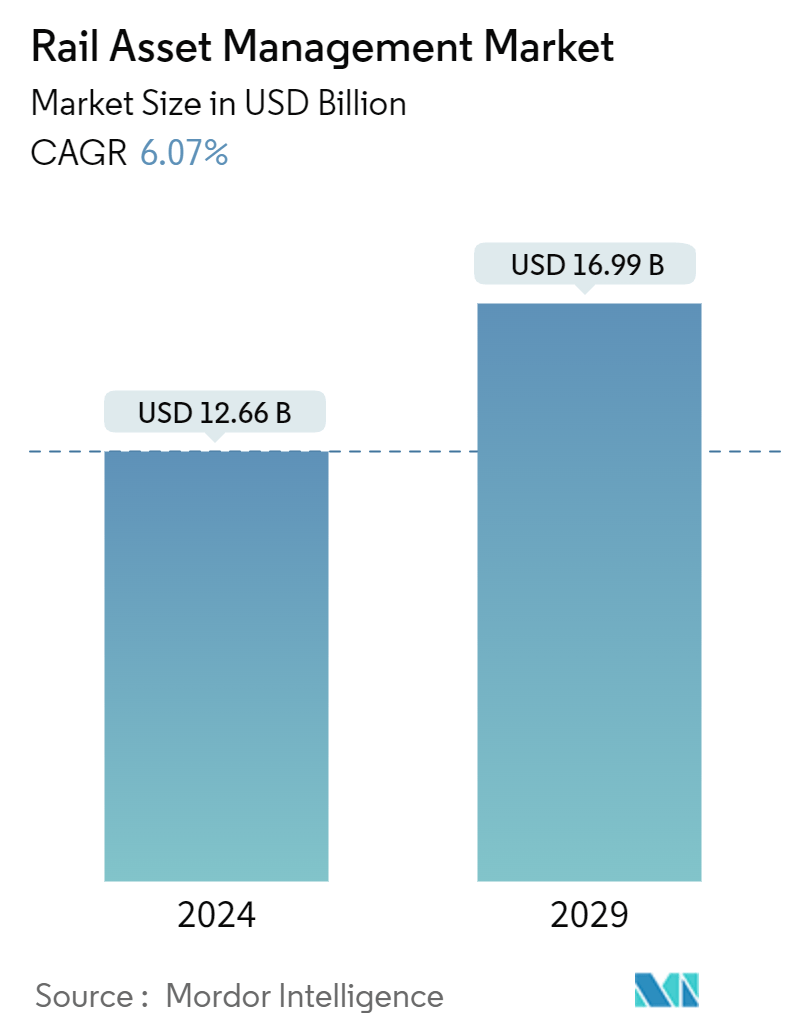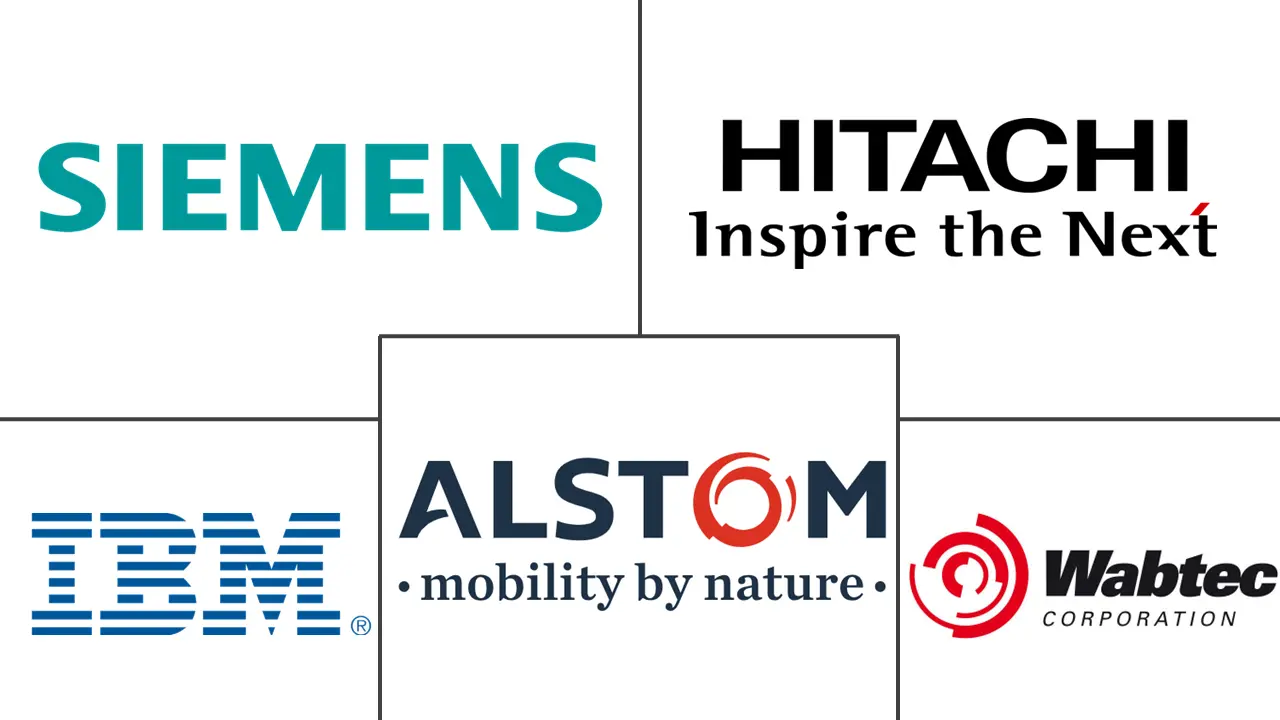Market Size of Rail Asset Management Industry

| Study Period | 2019 - 2029 |
| Market Size (2024) | USD 12.66 Billion |
| Market Size (2029) | USD 16.99 Billion |
| CAGR (2024 - 2029) | 6.07 % |
| Fastest Growing Market | Asia Pacific |
| Largest Market | Europe |
| Market Concentration | Medium |
Major Players
*Disclaimer: Major Players sorted in no particular order |
Rail Asset Management Market Analysis
The Rail Asset Management Market size is estimated at USD 12.66 billion in 2024, and is expected to reach USD 16.99 billion by 2029, growing at a CAGR of 6.07% during the forecast period (2024-2029).
The rail asset management solution comprises systems, processes, and tools which can be used to maximize operational performance and reduce risks over the whole rail infrastructure and vehicle life cycle. The solution includes real-time network management, security, information management for rail facilities, power supply management, infrastructure management, time management (HRM), incident management, etc.
- The governmental investments in various railway infrastructures and the trend of the PPP model for rail project implementation worldwide are driving the market. The need for rail asset management solutions will likely increase with more infrastructure and vehicles.
- In addition, PPP can speed up infrastructure construction and offer investment opportunities to the private sector, increasing the use of technology for operational effectiveness and accelerating the adoption of rail asset management solutions. Public and private investors may benefit from increased efficiency and a broader source of income from PPP rail projects that permit shared use of the tracks, which might lead to an improved rail network and increased competitiveness, thus driving the market due to its application in increasing operational efficiencies of the railways.
- For instance, as of May 2023, Tunisia's USD 11.7 billion planned investments in the rail sector are expected to be mostly funded through PPP mode by 2040. These funds are expected to support the government's initiatives to extend the Greater Tunis light metro network to connect the Tunis Lake region and the updation of rail cars between 2024 and 2026 by the Ministry of Transportation.
- However, due to high initial deployment costs, rail companies and infrastructure owners frequently face financial constraints when investing in asset management technologies. Organizations may struggle to set aside adequate funds to install comprehensive asset management systems. Budget restrictions might make delaying or scaling back deployments necessary, preventing the market from growing.
- Post-pandemic, rail freight, as well as travel via passenger trains, is expected to come to the pre-pandemic level, which may require rail operators to enhance passenger experience coupled with enhancing the operational efficiency of the rail, thus indicating growth in demand for rail asset management solutions.
Rail Asset Management Industry Segmentation
The rail asset management market is defined based on the revenues generated from the various solutions and services that are being used in applications worldwide. The analysis is based on the market insights captured through secondary research and primary. The report also covers the major factors impacting the market's growth in terms of drivers and restraints. The scope of the study has been segmented based on the deployment (on-premises and cloud) and application (rolling stock and infrastructure) around the world.
The Rail Asset Management Market is segmented By Deployment (On-Premises, Cloud), By Application (Rolling Stock, Infrastructure), and By Geography (North America(United States, Canada), Europe (United Kingdom, France, Germany, Rest of Europe), Asia-Pacific (China, Japan, India, Rest of Asia-Pacific), Latin America, Middle East & Africa). The report offers market forecasts and size in value (USD) for all the above segments.
| By Deployment | |
| On-Premises | |
| Cloud |
| By Application | |
| Rolling Stock | |
| Infrastructure |
| By Geography*** | |||||
| |||||
| |||||
| |||||
| Australia and New Zealand | |||||
| Latin America | |||||
| Middle East and Africa |
Rail Asset Management Market Size Summary
The rail asset management market is poised for significant growth, driven by the increasing demand for efficient and reliable rail operations. This market encompasses a range of systems, processes, and tools designed to enhance operational performance and mitigate risks throughout the rail infrastructure and vehicle lifecycle. Key components of these solutions include real-time network management, security, information management, and incident management, among others. The market's expansion is fueled by governmental investments in railway infrastructure and the adoption of public-private partnership models, which facilitate faster project implementation and offer investment opportunities to the private sector. These trends are expected to bolster the demand for rail asset management solutions, as they play a crucial role in improving operational efficiencies and enhancing the competitiveness of rail networks.
The Asia-Pacific region is anticipated to experience substantial growth in the rail asset management market, driven by emerging economies and increased governmental focus in countries like India, China, and Japan. This region presents a lucrative opportunity for market vendors to expand their businesses. The market is moderately competitive, with major players such as Siemens AG, Hitachi Ltd., Alstom, and IBM Corporation actively contributing to market share through strategic investments in research and development, partnerships, and technological advancements. These companies are involved in significant projects, such as Alstom's contract in Quebec City and SNC-Lavalin's role in Calgary's Green Line LRT project, which highlight the ongoing demand for advanced rail asset management solutions. As rail transportation continues to be a preferred mode of transport due to its efficiency and environmental benefits, the market is expected to grow, driven by technological innovations and the need for sustainable transportation options.
Rail Asset Management Market Size - Table of Contents
-
1. MARKET DYNAMICS
-
1.1 Market Drivers
-
1.1.1 Growing Demand for Effective Rail Operations
-
1.1.2 Increase in Government Initiatives and Public-Private Partnership Model
-
1.1.3 Rapid Urbanization in Developing and Underdeveloped Countries
-
-
1.2 Market Challenges
-
1.2.1 High Initial Deployment Costs
-
1.2.2 Difficulties with Legacy Infrastructure Integration
-
-
-
2. MARKET SEGMENTATION
-
2.1 By Deployment
-
2.1.1 On-Premises
-
2.1.2 Cloud
-
-
2.2 By Application
-
2.2.1 Rolling Stock
-
2.2.2 Infrastructure
-
-
2.3 By Geography***
-
2.3.1 North America
-
2.3.1.1 United States
-
2.3.1.2 Canada
-
-
2.3.2 Europe
-
2.3.2.1 United Kingdom
-
2.3.2.2 France
-
2.3.2.3 Germany
-
-
2.3.3 Asia
-
2.3.3.1 China
-
2.3.3.2 India
-
2.3.3.3 Japan
-
-
2.3.4 Australia and New Zealand
-
2.3.5 Latin America
-
2.3.6 Middle East and Africa
-
-
Rail Asset Management Market Size FAQs
How big is the Rail Asset Management Market?
The Rail Asset Management Market size is expected to reach USD 12.66 billion in 2024 and grow at a CAGR of 6.07% to reach USD 16.99 billion by 2029.
What is the current Rail Asset Management Market size?
In 2024, the Rail Asset Management Market size is expected to reach USD 12.66 billion.

